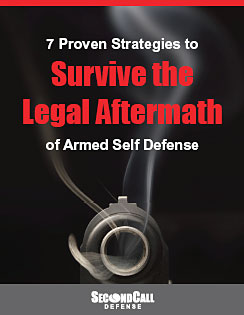The Order of Operations for Personal Self Defense
by Drew Beatty
In mathematics, “order of operations” refers to a specific application of rules or tasks that must be used in sequence to solve equations. There is also an order of operations for the approach to personal self-defense. And almost all of us do it out of order.
Most people buy the gun first, thinking that the firearm itself is most important. But that’s exactly backward. People buy the gear first because it’s cool, shiny, we can hold it and tell our friends about it. If you buy a gun you are automatically a “gun guy (or gal).” In a product-focused world, this is very common. But it’s still backward.
From some of the instructor-led classes I’ve taken and from other literature on the market, the proper order of operations for an effective self-defense is:
- Mindset
- Tactics
- Skill
- Gear
Mindset: Mental awareness will keep you safer than a gun, and is worth investing in with practice and research. The proper mindset of constant attention to self-protection will lead you away from trouble you may have gotten into without the proper mindset. Mindset tells you to park in a well-lit spot even if there is a dark spot closer to the door of the store. You do this because you realize you are reducing the risk of a criminal incident. Mindset tells you to double check that the doors are locked before you go to bed. Mindset also tells you that if there is going to be a fight for your life, you are the one who will be the victor. If you think about it, it’s probably your self-defense mindset that led you to purchase a gun in the first place.
Tactics: In winter I leave the house for work in the morning and it’s still dark. In addition to the small, hand-held flashlight I have in my pocket, I have adopted the tactic of having a headlight on my head to provide light in the darkness where I park. This helps me see in the dark, and also keeps my hands free if I need them. This is just one tactic I have adopted to increase my personal security.
Other tactics that directly enhance security include not going to places where trouble is likely to start, like wild bars known for fights. Lock the doors on your car and in your house. Don’t meet strangers in non-public places. These are easy tactics anybody can employ to enhance safety without needing a firearm.
There are more tactics in my earlier post, Situational Awareness.
Skill: Another way to define skill is “ability.” Do you have the ability to fight for your life if you had to? Are you physically fit enough to escape a bad situation by running from it? Are you able to help someone with basic first aid? These are some skill areas to consider for additional training if yours are not up to par.
There are also basic firearms skills, like un-holstering the firearm and getting a shot on target in a certain amount of time at a certain distance, and more complex skills, like quickly clearing a double feed and getting the gun back in the fight. Perhaps some hand-to-hand self-defense instruction and/or strength training is part of your skillset. These are some of the reasons skill ranks above gear on the order of operations.
Gear: Not much to say about this. Most of us bought our gun first, right?
The concept of an order of operations is essential to self-defense. When the subject is approached broadly, it is also easy to see that the firearm is only one piece of a complex puzzle. The point of keeping yourself safe is to have the firearm as a last resort. You can often keep yourself safe by focusing on the things that are more important, like mindset, tactics and skill.
Drew Beatty is a 50 year old husband and father, and a lifetime resident of the great state of Colorado. He is a long-time firearms enthusiast as well as a strong advocate for The Second Amendment.
“


